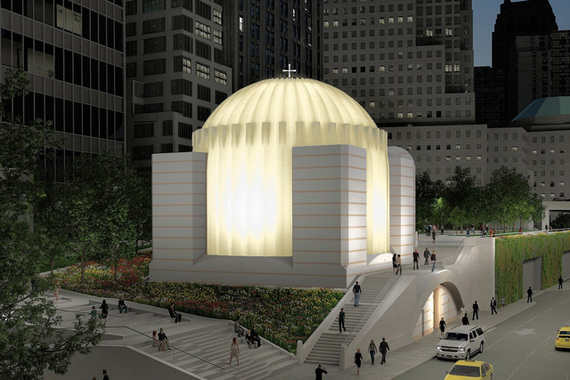On Saturday, October 18, New York politicians and Greek Orthodox clergy led a "Ground Blessing Service" for the construction of "St. Nicholas Shrine at the World Trade Center." Established in 1916 within an 1830s building, the original St. Nicholas church on Cedar Street was destroyed when the towers collapsed on September 11, 2001. At the ceremony for its rebuilding, speakers, including Governor George Pataki, Senator Chuck Schumer, and 9/11 families advocate Anthoula Katsimatides, stressed the religious and moral need for the church to return, as Pataki put it, in order to build a "rock of faith that anchors all that is done here at Ground Zero." The meaning of the reconstruction is understandably bound with the horror of September 11. Yet, as St. Nicholas is rebuilt at a new location, and with a different decorative form than its original structure, we should remember that the shrine will be important not only for its symbolism tied to the attacks, but for its renewed connection with the once vibrant immigrant neighborhood, known as the Lower West Side or "Little Syria," that existed in this part of the city. Sadly, this historic section has been aggressively torn apart and demolished by large-scale construction projects from the Brooklyn Battery Tunnel, to the World Trade Center, and now to subsidized post-9/11 real estate development. Rebuilding St. Nicholas offers an opportunity to recall this extraordinarily diverse and important quarter of the city, perhaps emphasizing that as we rebuild one historic structure destroyed unwillingly, other last remaining buildings should not be demolished by choice.
The original St. Nicholas church was a modest, four-storey structure first built around 1832 and used as a tavern in a sometimes seedy port area. While the church looked lonely and entirely out of place as it stood before the World Trade Center, which opened in the early 1970s, this was once a typical structure in a low-rise section of the city. The commercial district known as "Radio Row" was largely demolished to build the World Trade Center, and St. Nicholas's location on Cedar Street was the northern end of the "Little Syria" immigrant community that in the 1880s had shifted away ethnically from Germans and Irish. Given their cultural, culinary, and commercial affinities, it is not surprising that the Syrian, Lebanese, Greeks, and Armenians all congregated in this southwestern strip of Manhattan near the port and waterfront, running similar businesses grounded in international trade, peddling, and wholesale houses.
For several decades, next to St. Nicholas stood St. Joseph, a Catholic church that the Maronite community from modern-day Lebanon and Syria used for services after their earlier church on Washington Street was demolished for the Brooklyn Battery Tunnel in the 1940s. This replacement church was itself demolished in 1980s, leaving St. Nicholas alone in the parking lot next to the World Trade Center. In an incredible moment during the recovery after the September 11 attacks, workers discovered the original cornerstone from St. Joseph, with Latin inscription, as they were digging in the rubble around the spot of St. Nicholas on Cedar Street. This Arab-American artifact is now on display at Our Lady of Lebanon Cathedral in Brooklyn, and we can see it as a reminder of the ties between St. Nicholas and St. Joseph churches, and between the Greeks and Lebanese and Syrians.
The design for St. Nicholas by Santiago Calatrava is modern and sleek, and it evolves from the Hagia Sophia of Constantinople, rather than the 19th century architecture of the original St. Nicholas and the surrounding neighborhood. Some people were a bit surprised at this choice of architectural language, given that the Hagia Sophia and its dome made a tremendous imprint on Islamic architecture. However, these cultural combinations, embraced by the Orthodox, also align with the mutability and blending of world cultures that New York City, and "Little Syria" specifically, have thrived on.
The Greek Orthodox Archdiocese, appreciatively, recognizes that this new national shrine should serve an ecumenical need for spiritual comfort at the World Trade Center and within the frenetic financial district of Downtown Manhattan. At the blessing ceremony, Archbishop Demetrios of America said that the shrine will be "a source of comfort and inspiration for all people." The water used to bless the church came from the September 11 Memorial pools, and instead of installing a cornerstone for the foundation, the Archdiocese installed two carnes, or heaps of stones, that parallel the shape of the World Trade Center towers.
Although St. Nicholas will be rebuilt, the neglect of preservation and the opportunistic impulse for "renewal" have led to the demolition of other historic structures surrounding the World Trade Center site since September 11. These include a 1872 building at 21-23 Thames Street, as well as 4 Albany Street (the National Surety Company Building). The Landmarks Preservation Commission has declined to protect two nearby 18th-century Federal row houses at 94 1/2 and 96 Greenwich Street. And, directly tied to "Little Syria", the Downtown Community House at 105-107 Washington Street, which provided social services for the neighborhood, and a last tenement at 109 Washington Street remain under threat, despite constant attempts for over a decade by historians and preservationists to seek landmark designation. Without some compromise historic district initiative for Downtown Manhattan from Meenaskshi Srinivasan, the new chairperson of the Landmarks Preservation Commission, it seems likely that a regrettable legacy of September 11 will be the near total destruction of the physical heritage of the oldest section of New York City.
There is a risk that in anchoring Saint Nicholas National Shrine too completely in the narrative of September 11, we may miss connecting it to a deeper, more foundational American narrative as a remnant of a disappeared and demolished ethnic neighborhood of diverse peoples. Such neighborhoods built the United States, and, with its location near the entry point from Ellis Island and its diverse ethnic population of Scandinavians, Middle Easterners, and Slavs, the Lower West Side is one of the most critical of all. Admirers of the history of this part of New York City should celebrate the impulse to rebuild St. Nicholas, which may help establish a sense of community in Downtown Manhattan and offer a needed connection to the past. As Santiago Calatrava and the Greek Orthodox Archdiocese of America work to rebuild St. Nicholas, I hope that they will choose designs and symbols, as well as embrace cooperative ideas, that resonate with the church's origins in the Lower West Side of Manhattan and in "Little Syria."

